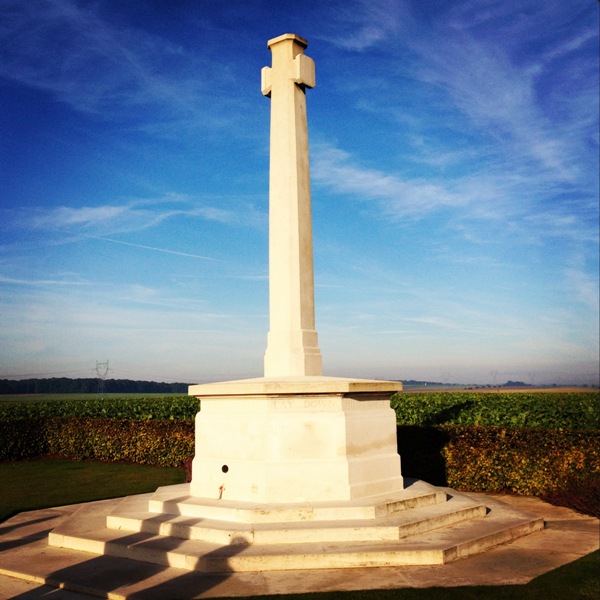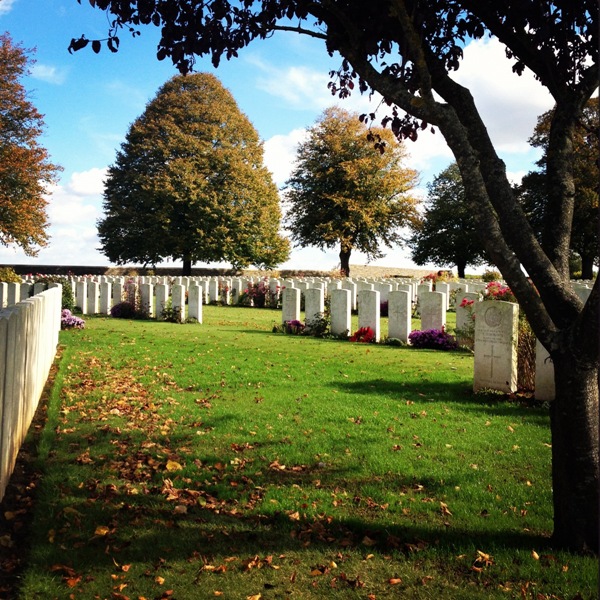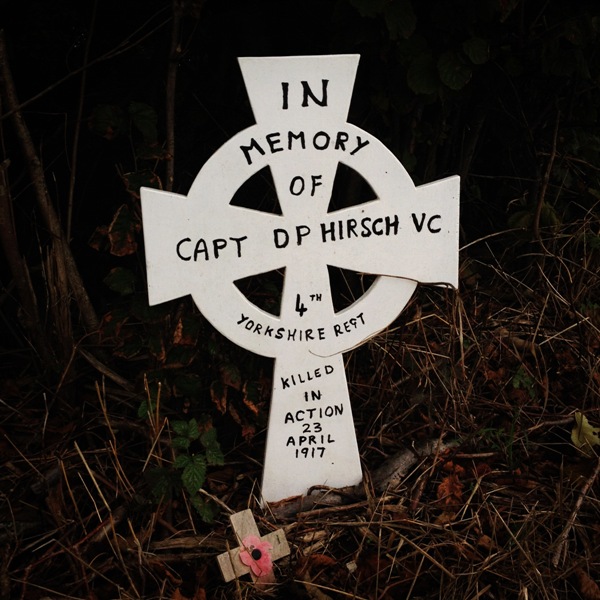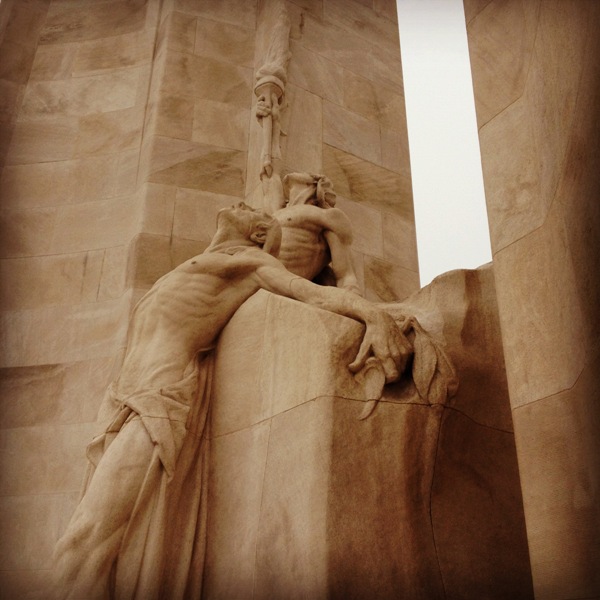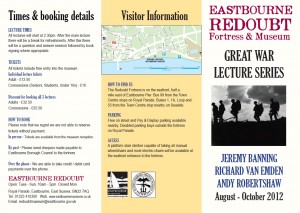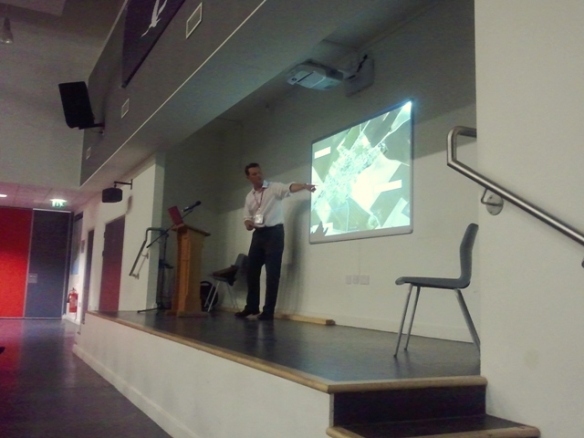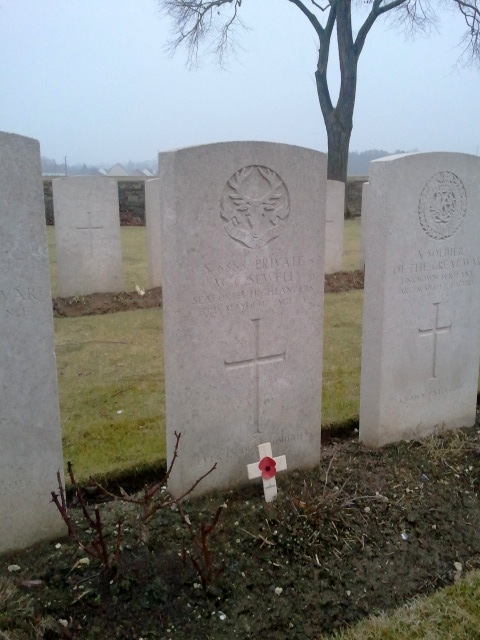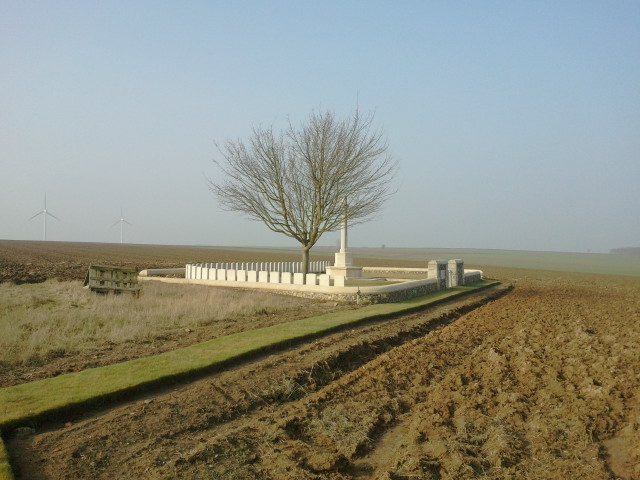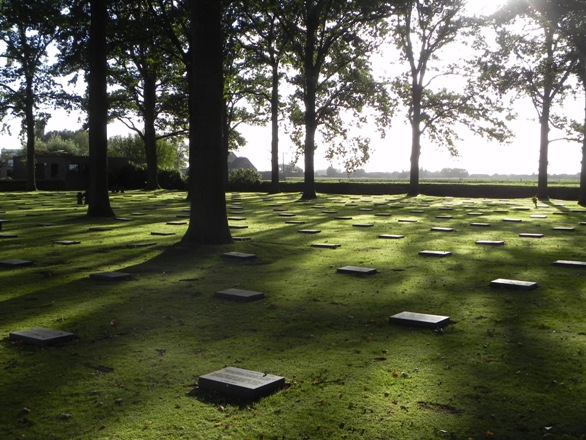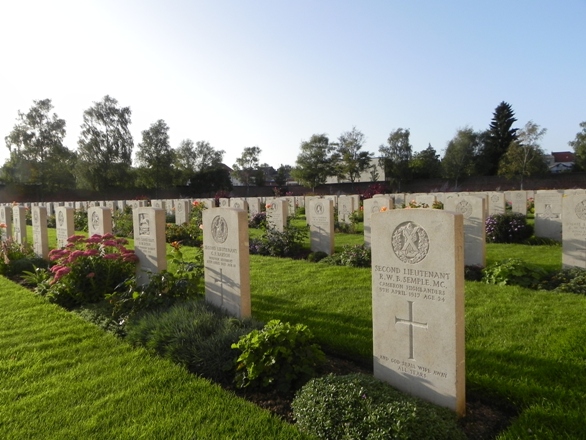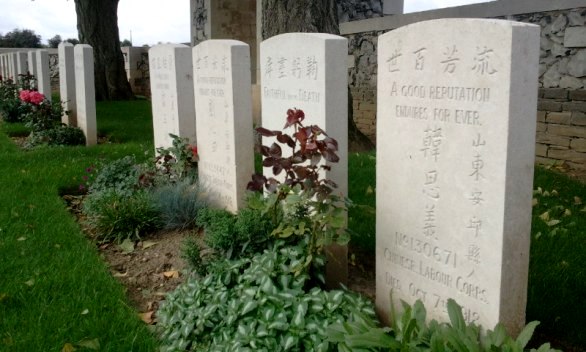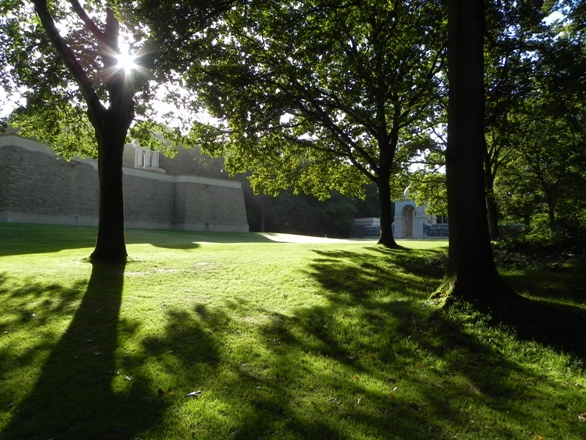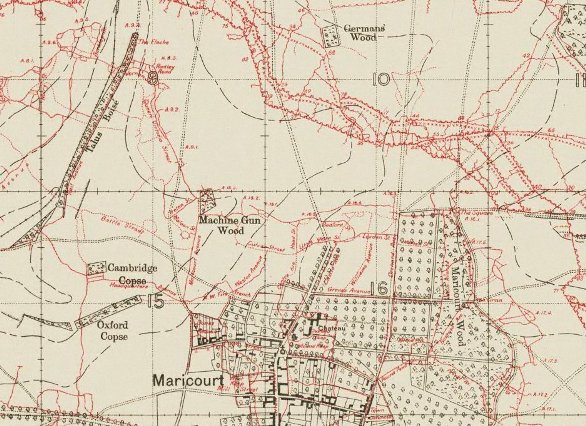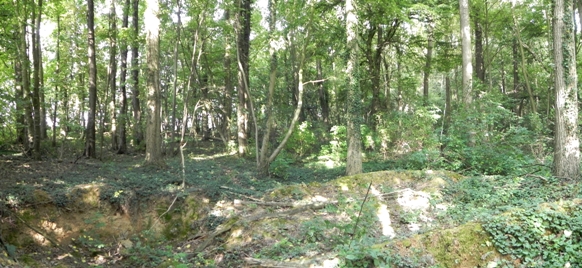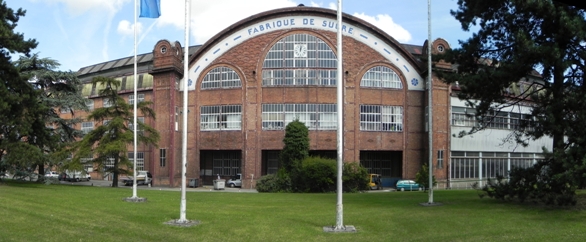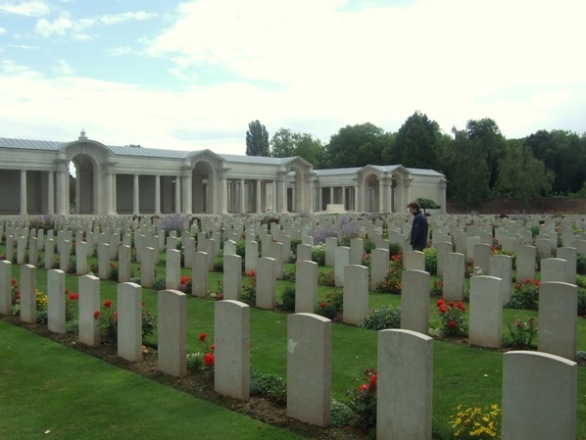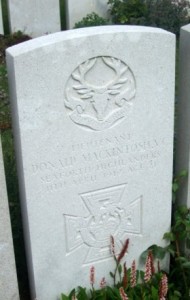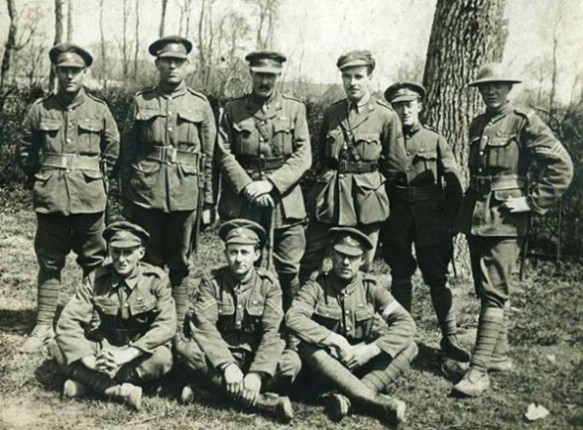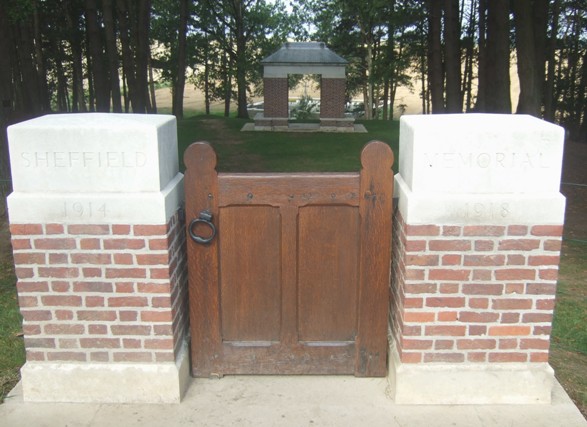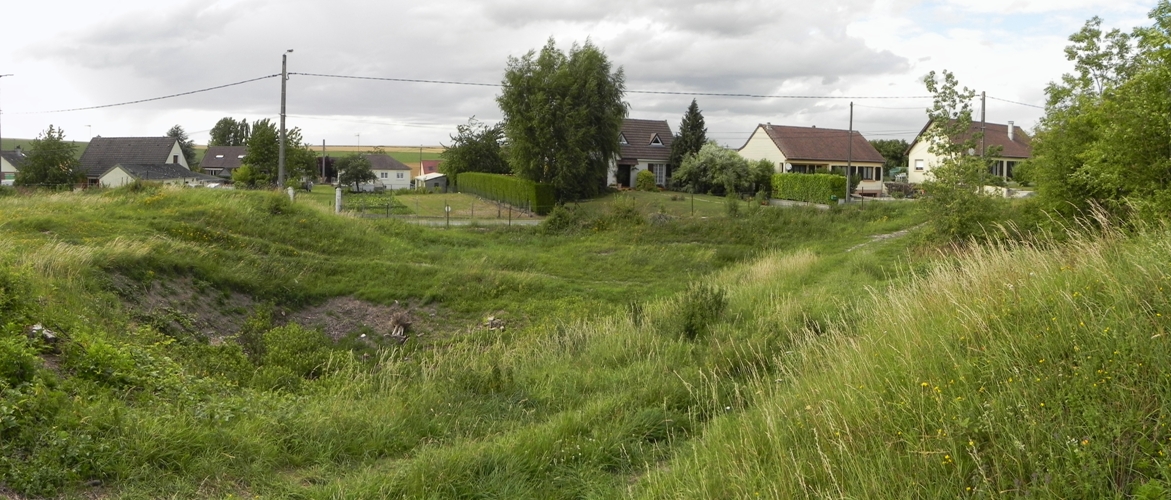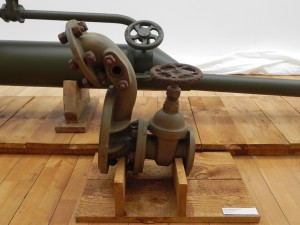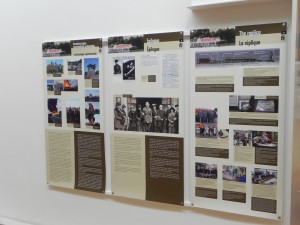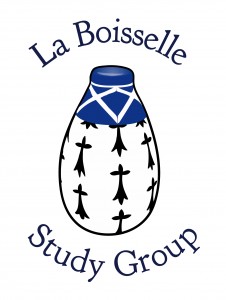Posts Tagged ‘Somme’
Writers battlefield trip to the Somme & Arras – October 2012
Earlier this month I finished an extraordinary week’s work at La Boisselle followed by four days guiding a group of writers around the Somme and Arras battlefields. Last year I had taken Vanessa Gebbie on a bespoke tour following in the footsteps of the 14th Battalion Welsh Regiment (Swansea Pals). She had been extolling the virtues of the battlefields ever since and had cajoled other writers to join her for a few days away.
Somme
After picking up my passengers and hire car in Lille we headed south to the Somme. Our first port of call was to the Glory Hole at La Boisselle where I was able to take my group underground. BBC News were covering our work on site that day and it was exciting to stand at the top of W Shaft and hear the filming taking place below for that night’s Six O’Clock News. Vanessa has written about this on her blog here. After a visit to the Lochnagar Crater we stopped at Becourt Military Cemetery and Norfolk Cemetery en route to our comfortable accommodation at Chavasse Farm, Hardecourt-aux-Bois.
“I can’t tell you what an amazing time I had on our trip. You are a natural – to call you either a historian or a tour guide is to miss the point entirely, I think. You brought it alive for us, you animated the land, the people, the history, in a way I don’t think I’ve ever experienced. There wasn’t one minute when you were talking where I was bored, where I zoned out. You made me want to know everything. And more than that, you inspired me to think about identity, nationality, what I might be prepared to die for.” Tania Hershman
The next day was spent on the Somme starting in the southern sector at the junction of British & French forces between Maricourt & Montauban. Stops that morning included Suzanne Communal Cemetery Extension to visit the graves of 18th Manchester Regiment men killed in May 1916 when German mortar fire blocked their mine shaft at Maricourt, the Carnoy crater field where I explained about the use of the Livens Large Gallery Flame Projector on 1 July 1916, Devonshire Cemetery at Mametz and then down to the impressive Red Dragon of the 38th (Welsh) Division Memorial at Mametz Wood. Despite heavy rain most of us had a walk up the slope from Death Valley to look at positions occupied by the 11th South Wales Borders and 16th Welsh in their unsuccessful 7 July attack on the Hammerhead. After a coffee and change of clothes we headed back out. Stops included Guillemont Road Cemetery, High Wood and the Nine Brave Men (82 Field Company RE) memorial in Bazentin-le-Petit before lunch at Old Blighty Tea Rooms, La Boisselle.
The remains of the afternoon was spent at Aveluy Communal Cemetery Extension, Mash Valley and the Thiepval Memorial to the Missing of the Somme before stopping at Flatiron Copse Cemetery, Mametz on our way back.
Over dinner that night I learnt one of my party had a relative with the 3rd Coldstream Guards who had been killed in the Battle of Flers-Courcelette on 15 September 1916. Our first stop the next morning was on the road between Ginchy and Lesboeufs to look at the starting positions for the attack. Guardsman Ernest Saye is commemorated on the Thiepval Memorial so there was a chance his remains were still lying in the fields before us.
We paid our respects at the Guards Division Memorial, Lesboeufs before a stop specifically requested by Vanessa at Morval British Cemetery. This quiet spot contains 38th (Welsh) Division casualties killed in the capture of Morval on 31 August/1 September 1918. After stops at the Cedric Dickens Cross and Delville Wood Cemetery & Memorial we headed north of the Roman Road to Thiepval to pick up where we had left off the previous day. Stops included the Ulster Tower Newfoundland Memorial Park, the Sunken Lane at Beaumont Hamel and then over the Redan Ridge for a picnic lunch in the majesty of at Serre Road Cemetery No.2 where the Somme part of our tour ended.
Arras
En route north we stopped at Ayette Indian & Chinese Cemetery before arriving at Neuville-Vitasse Road Cemetery, Neuville-Vitasse where I set the scene for the Arras offensive. The elevated position offers a fine viewpoint from which to show the southern sector of the battlefield with Monchy-le-Preux, Henin Hill and the route of the Hindenburg Line clear to see.
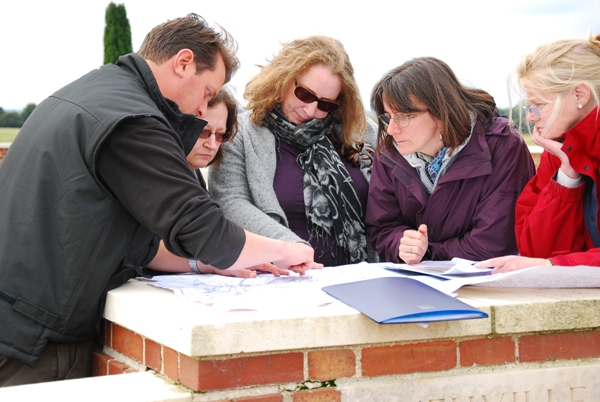
Poring over maps of the Arras battlefield at Neuville-Vitasse Road Cemetery. Thanks to Vanessa Gebbie for her permission to use this image.
After a visit to Cojeul British Cemetery to pay our respects at the grave of two Victoria Cross winners, Private Horace Waller and Captain Arthur Henderson we headed up to the open windswept ground of Henin Hill where we had a good look around a surviving German ‘mebu’ concrete pillbox, part of the Hindenburg Line defences in the area. After repeatedly getting in and out of the car we were keen to stretch the legs and so took a walk to Heninel-Croisilles Road Cemetery where I read the poet Siegfried Sassoon’s account of being wounded nearby. We then walked down to Rookery Cemetery and Cuckoo Passage Cemetery.
Our next stop was on Wancourt Ridge outside Wancourt British Cemetery where I read John Glubb’s detailed account of the bridging work undertaken by 7 Field Company RE across the River Cojeul in the valley before us on 23-25 April 1917. The landscape is wonderfully easy to match up to Glubb’s descriptions and offers the chance to imagine the scene 95 years ago. Afterwards some of us walked up to the site of Wancourt Tower. Our final stop of the day was the rarely visited but rather beautiful Vis-en-Artois Memorial. One of our party Caroline had a relative commemorated on the panels. Percy Honeybill, 1st King’s Own (Royal Lancaster Regiment) was killed on 2 September 1918 attacking the Drocourt- Quéant defences.
Our final day saw us head to Arras for a croissant and coffee breakfast in the Petite Place before a visit to the Arras Memorial to the Missing and Faubourg-d’Amiens Cemetery. We then headed out along the Arras-Cambrai road to find the spot between Guémappe and Cherisy where Third Army Panorama No. 556 was taken on 6 May 1917. Standing close to the spot where the image was taken it offers an ideal opportunity to visualise battlefield conditions in May 1917. Our next stop was at Kestrel Copse to see the new cross for Captain David Hirsch VC. We then headed north to Monchy-le-Preux where I explained the magnificent action which resulted in the capture of the village on 11 April 1917. One of our party’s grandfather had served in the Essex Yeomanry. I was able to show her Orange Hill and the fields which her grandfather would have galloped across on 11 April 1917. We then headed up Infantry Hill where I told of the disastrous Newfoundland and Essex Regiment attack on 14 April and the subsequent action by the “Men who saved Monchy”.
Crossing the River Scarpe to Roeux, we visited the site of dreaded Chemical Works, now a benign Carrefour supermarket and garage. I always find it a pity that there is nothing on the site to show the ferocity of the fighting here in April and May 1917. Lunch was taken in Sunken Lane Cemetery at Fampoux (written about here by Vanessa Gebbie ). We discussed the terrible fighting for Roeux and the 11 April attack by the 2nd Seaforth Highlanders and 1st Royal Irish Fusiliers. After visiting Gavrelle we headed north to Vimy Ridge, visiting the trenches and Walter Allward’s masterpiece, the Vimy Memorial where we bumped into my brother Mark guiding a group. What a small place the battlefields are sometimes! There followed an interesting journey back to Lille Europe station where the car was returned in a rather muddier state than it had been when picked up.
My thanks to Vanessa, Tania, Zoe, Angela and Caroline for being such good company and making the trip such a delight. I am already planning the itinerary for 2013!
“Thank you is really an inadequate word to convey my feelings about the weekend. I still feel as if I’ve been to a different place and had my life changed. I’m not quite sure how you managed it but it felt as if you really took us back in time to 1914, 1916, 1917 and 1918 and that we were standing alongside the men waiting for the whistles to send them over the top and later dragging or rolling themselves back to the safety of their trenches. I thought I knew a bit about the First World War having done a history degree and having read the poetry. At an intellectual level I suppose I did know about the war but emotionally I had no idea what it was like for the men and that experience was what you gave us with the maps, the panoramas and all the stories. Over the last few days they lived and breathed again. It’s difficult to pick out my favourite moments as everything felt like a highlight. I can’t remember if it was Tania or Zoe who said they’d never before come across a guide who didn’t bore them for a second. Actually ‘guide’ isn’t the right word – the ‘expert’ comes closer but also the ‘enthusiast’ brimming over with things you wanted to share.” Caroline Davies
I am back in Bristol after a delightful weekend spent in Sussex. On Saturday I gave a lecture entitled Somme Archaeology: The Glory Hole and the work of the La Boisselle Study Group at Eastbourne Redoubt Fortress & Museum. Despite it being a boiling hot day and the lure of the sea only a few yards away it was standing room only by the time I began speaking in one of the Redoubt’s (thankfully cool) casemates. My talk focussed on the La Boisselle Study Group’s work since June 2011, showing images from the British tunnel system as well as images of surface archaeology and artifacts. I spoke about the actions of the French in autumn 1914 with focus on the capture of the Granathof by the 118th Infantry Regiment on Christmas Eve 1914. British occupation of the ‘Glory Hole’ was also covered with especial mention of underground action by 179 and 185 Tunnelling Companies, RE. I was able to show the current state of excavation and explain the plans for the next buy ambien cheapest tranche of work in September/October. This includes potential exploration of the British tunnel system at the 80ft level.
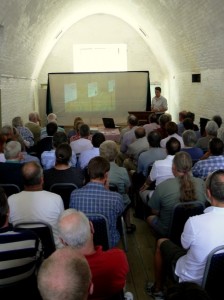 After an hour’s lecture there was a tea break which was followed by a further 25 minute Q&A session. It was good to see friends there, especially Richard Dunning, owner of the Lochnagar Crater. My grateful thanks to Ryan Gearing for organising the series of lectures, Keith Ross (ex-Royal Sussex Regiment) for his kind introduction and the Eastbourne Redoubt Fortress & Museum for providing such an inspiring venue.
After an hour’s lecture there was a tea break which was followed by a further 25 minute Q&A session. It was good to see friends there, especially Richard Dunning, owner of the Lochnagar Crater. My grateful thanks to Ryan Gearing for organising the series of lectures, Keith Ross (ex-Royal Sussex Regiment) for his kind introduction and the Eastbourne Redoubt Fortress & Museum for providing such an inspiring venue.
September’s lecture is to be given by Richard van Emden who, utilising his research material gathered for his book ‘The Quick and the Dead’ will be speaking about loss, grief and the families who are often forgotten when the fallen are remembered. Further details can be found here: http://www.eastbournemuseums.co.uk/Events.htm
On Saturday 18 August I will be the first speaker of the Eastbourne Redoubt Fortress & Museum Great War lecture series. My lecture “Somme Archaeology: The Glory Hole and the work of the La Boisselle Study Group” begins at 2.30pm. Ticket prices are £12.50 (Adult) with a concession price of £10 for Senior Citizens, Students and Under 16s.
Further details can be found here: http://www.eastbournemuseums.co.uk/Events.htm
Other speakers for September and October are my good friend Richard van Emden and Curator of the RLC Museum, Andy Robertshaw.
The lecture will showcase the work undertaken since June 2011, giving a history of French, German and British warfare (surface and subterranean) at La Boisselle from 1914-1916. I will also include many images previously unseen showing British tunnels dug in September-October 1915.
A pdf document with details of all three talks can be downloaded by clicking on the image below.
On 13 June I gave a talk to 65 students and staff at South Bromsgrove High School on the work of the La Boisselle Study Group. Soon after media coverage began on our work in June 2010 I was contacted by James Wilson from the History department who was keen to learn more and, if possible, visit the site on the annual school battlefield trip.
My talk focussed on our current archaeological work as well as the wartime history of the site. It was satisfying to be given the opportunity to do justice to the resolute French fighting for the village and Granathof in 1914/15. French efforts on the field of battle are often overlooked, something that we are seeking to redress at La Boisselle. I went on to talk about the handover to British troops in summer 1915 and their subsequent efforts, both above and below ground.
Your talk was very well received by both staff and students alike, indeed some of the students have come to find me this morning to ask if we can arrange to come and volunteer at the site; a definite sign that the talk was delivered at the right level. I have to say that it was absolutely what we were looking for, it both enthused and moved the audience through the personal stories you used throughout. I would personally recommend your lecture to anyone who has a interest in the La Boisselle area, or indeed anyone who has an interest in history, a truly captivating talk by an inspirational historian! Mr James Wilson, History Teacher, South Bromsgrove High School
Sadly, this year it was impossible to show the school’s battlefield trip around the site but we aim to do so next year. I have also been asked back to the school to speak next year and look forward to visiting again. My thanks to James Wilson and his colleagues for their generous welcome and feedback. Many thanks to the students for their faultless attention. As a firm believer in the power of education it was immensely rewarding to be able to share my experiences of La Boisselle to school students.
Should you be interested in having me talk at your school or group then please contact me directly.
From 2 – 4 March I was guiding a private battlefield tour. Late last year I had been asked to compile a report on S/8888 Private William Charles Sewell who served in the 2nd Battalion Seaforth Highlanders. William Sewell went overseas in November 1915, served through the Somme in 1916 and was killed at Roeux during the Battle of Arras on 3 May 1917. As well as compiling a detailed report on William Sewell’s war service I was asked to take his great nephew, Paul Carter with his friends to follow in William’s footsteps from Arras down to the Somme.
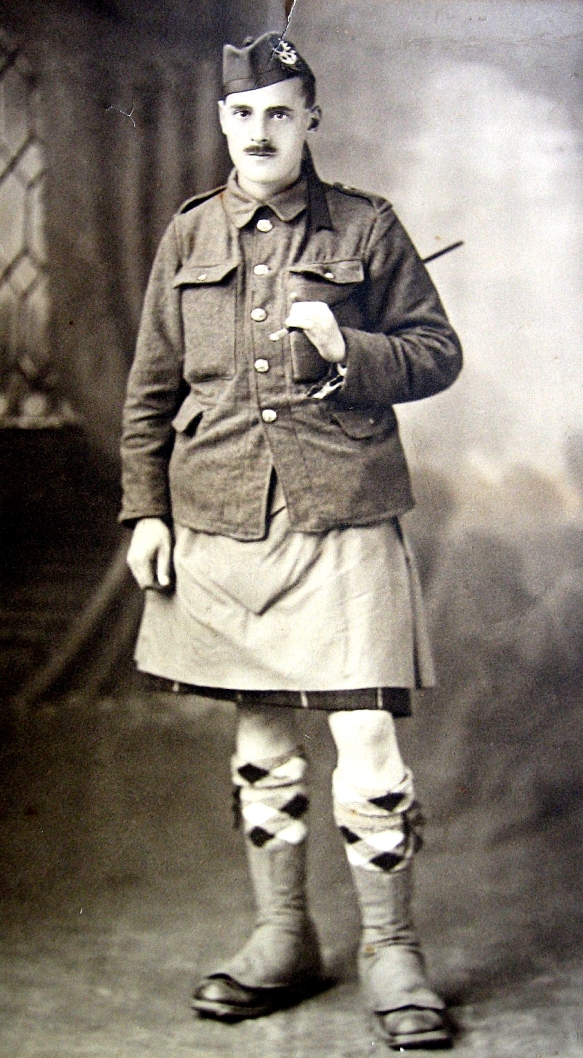
Private William Charles Sewell, 2nd Battalion Seaforth Highlanders. Killed 3 May 1917 during an attack at Roeux during the Battle of Arras. Many thanks to Paul Carter for his permission to use this photo.
Despite a distinct lack of decent weather for the entire trip we had a wonderful time and it was a real honour to be guiding the first member of William Sewell’s family to ever visit his grave. Starting at Vimy Ridge and the Memorial Park we began our tour of the Arras battlefields. After a stop at La Targette for the enormous French and German cemeteries we picked up the Athies road, following in the footsteps of the triumphant 9th (Scottish) Division in their advance on 9 April 1917. After a quick stop at Point du Jour Cemetery and the 9th (Scottish) Division memorial we headed to Fampoux, tracing the route of the 4th Division as they leapfrogged the Scots that day. Stopping at the Seaforths Cross at the Sunken Lane I explained the disastrous attack on 11 April 1917 and read an account of the operation from Private James Stout, a survivor of the attack. As one of those actions that holds a particular fascination for me it was all the more poignant being there with a relative of a soldier who may well have taken place in that ill-planned venture. The following account provides a bleak picture of subsequent events:
At ZERO Hour (12 noon) 2nd Seaforths and 1st Royal Irish Fusiliers advanced, the former on a 3 company front, the latter on a 2 company front. The 2nd Seaforth Highlanders’ objective was the cross roads I.13.a.9.3, exclusive to cross roads I.7.a.4.3 exclusive. Immediately these two battalions advanced, they came under a very heavy machine gun fire from the INN, CHEMICAL WORKS, STATION, CHATEAU and Railway Embankment. The whole ground in Squares H.12 and 18 appeared to be swept by machine gun fire.
At the same time a barrage was put down on FAMPOUX and East of the SUNKEN Road where the remaining two battalions were assembling. This machine gun fire very soon thinned the advancing lines but the troops continued to advance.
On the left, part of a company of the 2nd Seaforth Highlanders entered a new trench some 150 to 200 yards west of the 1st objective, about I.7.c.5.9.
This party under an officer [Lt Donald Mackintosh] maintained itself in the trench for some time, until its ammunition was exhausted, when they were forced back by a counter attack and only a few returned. The remainder, including the officer who is missing, were either killed or wounded, and left in this trench.
The heavy machine gun fire maintained by the enemy made it impossible to obtain information regarding the course of the action but it required no report that a single wave of 400 men who had to advance an average distance of 400 yards with a Battalion front of 1100 yards could not obtain their objectives in face of such machine gun fire and rifle fire.
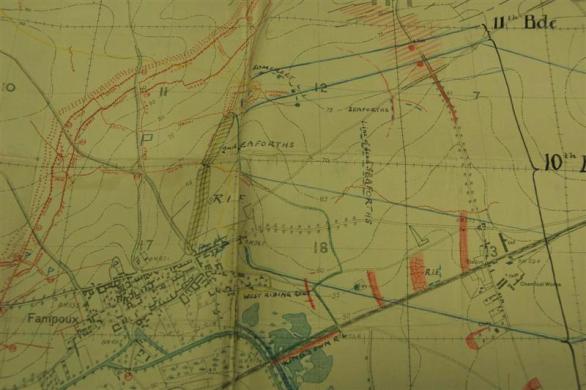
Map extract from 10th Brigade war diary showing 'line of dead Seaforths'. Ref: WO95/1479 10th Infantry Brigade War Diary. Copyright National Archives & reproduced with their permission.
After the debacle of 11 April 4th Division went back for some rest. Their next large-scale attack was the fighting at Roeux on 3 May. It was during this fighting that William Swell was killed. Starting next to the A1 motorway at Crump Trench Cemetery we followed the battalion through their part in the battle. The following map shows the objectives, named respectively the BLACK, BLUE and RED Lines. The total advance was so far as the 4th Division was concerned was to cover a distance of 2500 yards, including:
- The capture of the Northern portion of the village of ROEUX, including the CHEMICAL WORKS and STATION buildings.
- The capture of the trench system on the high ground near HAUSA and DELBAR Woods, and finally
- The piercing of the defences round PLOUVAIN, which were partially wired.
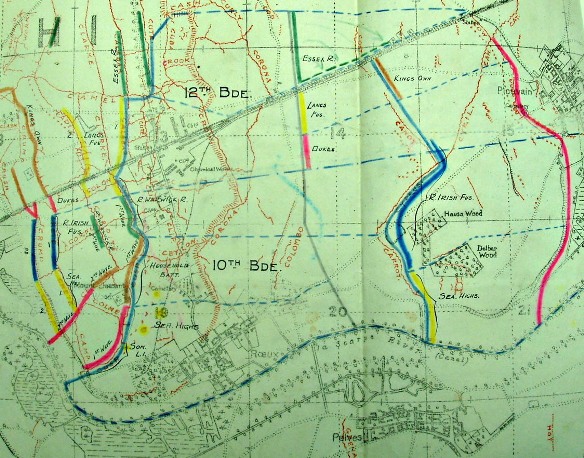
3 May 1917: the 4th Division's attack plan for Roeux . Positions for the 2nd Seaforths can be seen marked in yellow. Ref: WO95/1446 4th Division War Diary. Copyright National Archives & reproduced with their permission.
Of the attack, the war diary notes:
3 May – Zero hour 3.45am when a heavy bombardment of enemy’s position started, lasting for half an hour. Barrage then crept forward very slowly. Battalion left their trenches at 4.30am, being in support to the Household Battalion who were to capture the cemetery north of ROEUX. The Royal Warwickshire Regiment were on the left of the Household Battalion and Royal Irish Fusiliers on left of Seaforths, support to Royal Warwickshire Regiment. 1st Somerset Light Infantry were on the right and were to capture village of ROEUX. On reaching BLUE Line which was just west of DELBAR WOOD the Battalion moved to their right until left of each wave was opposite NW corner of DELBAR WOOD where a halt was made until ZERO + 85 = 5.10am when they advanced to capture the RED line, east of DELBAR and HAUSA WOOD, and immediately west of PLOUVAIN, through I.21.b. and I.15.d & b. This attack unfortunately failed owing to both flanks being held up and severe losses, and later on the whole Brigade line was forced to withdraw to original front line. The Battalion came back to CRETE Trench. This was the position until dark when the Battalion was sent to relieve the Household Battalion in CEYLON Trench from its junction with CORONA Trench I.19.a.8.7. to its junction with COX Trench I.19.a. 7.3. Company Sergeant Major Fraser was in charge of the line as all officers taking part in these operations had become casualties. The Commanding Officer, Adjutant, Medical Officer and three other officers became casualties of the same shell.
Delbar and Hausa Wood no longer exist. Le Lac Bleu (Blue Lake) now covers the ground on which the woods sat. Unless there is specific personal testimony it is notoriously hard to pinpoint the exact spot that a soldier was killed. However, as most casualties were sustained between the BLUE and RED lines it seems likely that William Sewell was killed in this area. Having followed the route of advance we returned to the ground between Fampoux and Roeux to pay our respects at William Sewell’s grave.
Crossing the Scarpe we drove up in Monchy-le-Preux and up Infantry Hill where I recounted the story of 14 April attack by the 1st Essex and Newfoundlanders and the resulting action of the small band of men who saved Monchy from German recapture. For our last stop of the day we headed to the Arras Memorial to Missing.
Next morning began with a windswept walk on the Hindenburg Line to the quiet delight of Rookery Cemetery and Cuckoo Passage Cemetery, the latter full of men of the Manchester Regiment killed on 23 April 1917.
We then headed back into Arras for a good tour of the underground boves and tunnels at Wellington Quarry. Our brief visit to Arras was now at an end as we headed south down to the Somme battlefields.
Our first stop was the Sheffield Memorial Park and the Gospel Copses at Serre (the 2nd Seaforths held the frontline trenches here in November – December 1915). We then headed to Redan Ridge to look at the part played by the 2nd Seaforths in the opening day of the Battle of the Somme, 1 July 1916. The operation plan was for 11th Brigade to take Munich Trench and then for 10th and 12th Brigades to pass through them at a given time and gain the final objective along the Beaucourt Ridge (2nd Seaforths were part of 10th Infantry Brigade)
The war diary offers the following explanation of events:
Zero at 7.30am. From 5.30am the very intense bombardment concentrated on the German trenches in front. At 7.30am the 11th Brigade moved forward from our front in waves.
By 8.45am no messages had come through from 11th Brigade. Patrols advanced and were met by heavy machine gun fire. Telephone to Brigade HQ was out so two orderlies were sent for orders. As they had not arrived by 9am – the hour appointed for the Battalion advance – the remainder of the Battalion moved forward.
On coming into view of the German trenches the Battalion came under heavy machine gun fire from the front and direction of Beaumont Hamel. After passing the German front, parties pushed forward and reached the third line of trenches. Other parties of our men may have reached Munich Trench but there was no possible communication and none returned.
By this time 11th Brigade had already lost their Brigadier, General Prowse (died of wounds) and all four Commanding Officers (killed). Enemy held first, second and third lines on our left and right. Attempts were made to consolidate the ground gained. Enemy bombed on flanks and the third line was given up at about 1pm.
By 11am there were only 5 officers left with the battalion and casualties were proportionately heavy in the ranks. During the evacuation of the third trench Drummer Ritchie sounded the Charge with the idea of encouraging these waverers who had lost their leaders. This gallant action in addition to his conduct throughout the day gained him the Victoria Cross.
We finally withdrew at about 5pm to original front line positions south of the Quadilateral. At this time there were about 40 men of the battalion left.
The war diary records the following casualties:
| Officers | Other Ranks | |
| Killed | 12 | 59 |
| Died of wounds | 1 | 6 |
| Wounded | 8 | 260 |
| Missing, believed killed | 0 | 1 |
| Missing | 0 | 53 |
| TOTAL | 21 | 379 |
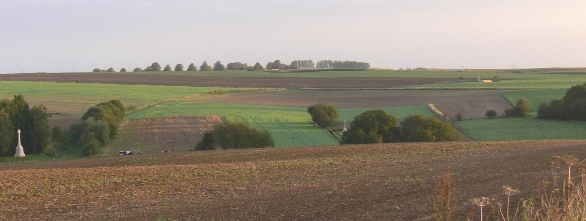
Redan Ridge viewed from a position on the Hawthorn Ridge. The German-held village of Beaumont Hamel is to the right of frame.
Further stops that afternoon included the Sunken Lane at Beaumont Hamel, scene of the infamous attack by 1st Lancashire Fusiliers on 1 July, Newfoundland Memorial Park with its preserved trenches and the Ulster Tower and Thiepval Memorial to the Missing. We finished by following the front line by Authuille Wood to Ovillers, down Mash Valley and then to the hotel at Albert.
Our final day dawned in thick fog which made pointing out sites rather difficult. Beginning with a stop at Fricourt and the Bois Francais we followed the British front line and saw the site of Siegfried Sassoon’s Military Cross action before heading to the site of the Livens Flame Projector site at Mametz. Dropping down to Devonshire Cemetery we headed toward Maricourt and the junction with the French Army on 1 July. Passing Trônes Wood, Guillemont and Ginchy we headed to the desolate fields between Lesboeufs and Le Transloy for our last in-depth look at the part played by the 2nd Seaforths during the Somme battle. Fighting in desperate mud with a thick mist (not unlike the weather on the day we visited) the battalion took place in two attacks in mid-October against German positions in Dewdrop and Rainy Trench. The Battalion war diary recorded the ground conditions in the area:
From Montauban eastwards the whole country is one stretch of absolute desolation – a more gloomy sight I have never seen. The ground is just a maze of shell holes, varying from size of stokes mortar crater to the size of a crater made by a 15-inch.
The attacks on the 14th and 23rd were pressed with utmost gallantry but typical resolute defence from German troops allied to the dreadful ground conditions encountered made any serious advance impossible.
After a walk around Delville Wood and a stop at Flat Iron Copse Cemetery and the Welsh Dragon Memorial at Mametz Wood we ended up at the Glory Hole at La Boisselle where I was able to show them around site and take them underground in W Adit. It had been a real pleasure spending time with these gentlemen. Thanks to Paul Carter and his friends Tim Halliday, Al Kendall and Richard Johnson for making me so welcome. I hope that we can do it again sometime soon – perhaps Ypres next time?
Thank you very much for the wonderful report on my Great Uncle William Sewell and the tailor made trip following in his footsteps 97 years later. Your local knowledge, historical expertise and professional service gave my small group a fantastic tour- better than we could have hoped for. The stories of individual’s personal experiences brought an extra dimension to the trip and brought to life briefly a few of the thousands of names inscribed on memorial walls or grave stones. We all agreed that trip would have been so much less of an event if we had tried to find our own way around, and we would have missed so many significant points. The battlefield overlays and WW1 panoramas were fantastic to relate to as we stood in the centre of all those events and you recounted the events played out. On our journey back there was plenty of talk about the next trip – until then! Paul Carter
I know all four of us found the experience fascinating, thought provoking, educational and frequently moving as well. Your own passion and knowledge of a crucial era in our history was captivating and I am sure like me, the other guys have been singing your praises to those they have talked to about the trip. It certainly was a weekend to remember. Al Kendall
A few weeks ago I took a couple, Mac & Marian from New Zealand, around the battlefields. They had asked me to show them around the Western front for three days before catching a train to Paris for the next leg of their trip. What made this trip so special was that we were following Corporal Andrew McDonald, 6th Seaforth Highlanders. Andrew McDonald died of wounds on 13 April 1917 and is buried at Etaples Military Cemetery. His battalion was involved in the opening stages of the Battle of Arras. It is highly probable that he was wounded when the battalion ‘went over the top’ in front of Roclincourt at 5.30am on 9 April 1917. I had previously written about the area in a piece entitled 6th Seaforth Highlanders at Roclincourt – The Battle of Arras, 9 April 1917.
After picking up Mac & Marian at Folkestone we took the tunnel over and then headed along the coast to Etaples. They told me that they had visited Second World War cemeteries before but I could see how moved they were when we pulled up at Etaples. The cemetery, the largest Commission cemetery in France, was designed by Sir Edwin Lutyens. The scale of the place defies belief and really deserves to have more visitors. After visiting Andrew’s grave and laying a small cross – something that Mac had been wanting to do for years – we spent a couple of hours just walking around this vast and sobering cemetery – the final resting place for 11,500 men and women.
Retracing our steps back up the motorway we headed to Ypres where I took them to various spots around the salient including Pilckem Ridge, Polygon Wood, Robertson’s Bridge at Reutel, The New Zealand Division Memorial at Gravenstafel, Tyne Cot Cemetery and finally the German Cemetery at Langemarck. We headed back to our excellent B&B and then back out to Ypres so we could attend the Last Post ceremony at the Menin Gate. We ate in the square before heading back to the B&B for a good sleep after a long day.
The next day was to be spent around the Arras battlefields. After a mammoth breakfast we set off south, firstly stopping at Nine Elms Cemetery at Poperinghe to pay our respects at the grave of David Gallaher, captain of the All Blacks.
We had a quick stop at Peckham and Spanbroekmolen, two of the huge craters formed by the Messines mine explosions on 7 June 1917 before heading south via Ploegsteert and into France to our next stop at La Chapelle-d’Armentières. It was here, at the site of the Railway Salient that Andrew McDonald’s brave actions during a trench raid on 15 September 1916 earned him the Military Medal. I was able to stand Mac at a spot looking down the railway line to where the German salient jutted out into No Man’s Land and explain the events of that night. We then continued south, stopping at Noeux-les-Mines Communal Cemetery & Extension to pay our respects at Marian’s great uncle, David Watson’s grave. He had been killed during the Battle of Loos whilst serving with the 1st Battalion, Cameron Highlanders. Leaving the coalfields of Gohelle behind us we began our look at the Arras battlefields.
I started with a stop at the village of La Targette with its staggering French and German cemeteries. If ever there is a place to fully appreciate the extent of losses suffered by our French allies and German foe then this is it. Neuville St Vaast Soldatenfriedhof has over 44,000 German buried within its grounds – a truly sobering place. We then headed to Vimy Ridge where, after a tour of the trenches, we headed to Walter Allward’s magnificent Vimy Memorial.
Next up was a special visit to the exact spot outside Roclincourt where ‘C’ Company, 6th Seaforths attacked on 9 April 1917. It was in the fields between the British front line and second German line (the area now contains the beautiful Highland Cemetery) that Andrew McDonald most likely received his fatal wound.
After an emotional stop at Highland Cemetery to visit other 6th Seaforth men we continued our tour through St Laurent Blangy and Athies to the Seaforths Cross at Fampoux. We then headed to the infamous village of Roeux (heavily fought over by the 51st Division in April and May 1917) and crossed the Scarpe to Monchy-le-Preux, Infantry Hill and then back down the Arras-Cambrai road to the superb Carrière Wellington tunnels. Our final stop of the day was at the Faubourg d’Amiens Cemetery & Arras Memorial to the Missing where, bathed in evening sunlight, we wandered at our leisure. After a meal in the Grande Place we headed off for a much-needed sleep.
The following morning saw us continue south down to the hallowed ground of the Somme battlefields. Mac & Marian had asked for unusual stops so, en route, we stopped at the quiet Ayette Indian & Chinese Cemetery.
Continuing south we visited Sheffield Memorial Park at Serre where I explained about the destruction of the Pals battalions of the 31st Division on 1 July 1916, the First Day of the Somme. We then headed over the Redan Ridge to Beaumont Hamel where, as well as looking at the disastrous attack by 29th Division troops on 1 July I gave a detailed explanation of the 6th Seaforth’s role in 51st Division’s successful attack on the village bastion on 13 November. We then visited Mailly Wood Cemetery to visit the graves of 6th Seaforths men killed in that attack. Most notably I had wanted them to visit the grave of 2/Lt Donald Jenkins MC. He had won his Military Cross in the same raid that earned Andrew his Military Medal – in fact, both men had crossed No Man’s Land three times bringing back wounded men on each occasion. Undoubtedly, despite the officer/other rank divide there would have been some connection between Andrew and this officer now lying at peace in Mailly Wood Cemetery.
Other stops that afternoon included a good stroll around Newfoundland Memorial Park, the Ulster Tower and Thiepval Memorial to the Missing. Having stopped at Mash Valley I took Mac & Marian on a private tour of the Glory Hole at La Boisselle (http://www.laboisselleproject.com/) before our final stops of the day at the Caterpillar Valley Cemetery for the New Zealand Memorial to Missing from September/October 1916 and the New Zealand Division Memorial at Longueval.

Early evening at Caterpillar Valley Cemetery. A ray of sun pierces through the clouds to strike the ground.
Passing High Wood I was able to point out the position of Seaforth Trench, dug by 6th Seaforths in July 1916 before heading off to our B&B at Flers for a well deserved beer, meal and chat.
The final day dawned with beautiful sunshine and so, rather than dropping Mac & Marian off in Amiens as had been agreed, I took them just down the road to Delville Wood and the South African Memorial. We were the first ones to visit that day and the atmosphere and light were quite superb.
After a circuitous tour to Ginchy, Guillemont and Montauban I stopped at the site of the Carnoy craters to tell them about the successful use of the Livens Large Gallery Flame Projectors employed there on 1 July 1916. Moving on to Amiens, we visited the splendid cathedral before I bade them a fond farewell at the railway station. It was another trip to be remembered with lovely people – thanks Mac & Marian for making it such a great time for me too.
More photographs from this trip can be seen on my dedicated Flickr page: http://www.flickr.com/photos/67774984@N03/sets/72157627598624551/
“Thank you for a fantastic trip in September 2011. We were lucky enough to travel with you for three and a half (far too short) days and experience your enthusiasm and passion for WW1 and the Somme first hand. We needed a lot longer. On your website you mention Corporal Andrew McDonald. He is my husband’s Great Uncle lost in 1917. During our time with you he came back to life and it was marvellous to be able to tread the same ground that he walked and to see similar sights. The report that you provided to us will hopefully inspire some other family members to travel to France and Belgium and to utilise your knowledge and enthusiasm for the Western Front and the Somme. You were willing to take us out of our comfort zone and show us areas, memorials and cemeteries that we had no idea could exist from the smallest to the largest including German, Indian, Chinese, Kiwi, Aussie, French, British, South African, Canadian etc. More than we had hoped for or realised that we would have ever seen. Thank you for your ability to generate interest and create great memories.
We would suggest that anyone who contemplates visiting Gallipoli and the Somme, visit Gallipoli first as the memories of France and Belgium will be stronger than those of Gallipoli. Jeremy was a fantastic guide who took care of us and took us to places we could never hope to see or find on our own. His contacts, his advice, the accommodation he organised and all aspects of the trip were 110%. Thank you for your time and efforts and we both wish you well for the future. Keep guiding.” Marian & Mac Macdonald, Pukekohe, New Zealand
Bespoke battlefield tour walking in the footsteps of Corporal JT Davies VC, 11th South Lancashire Regiment
Earlier this month I spent an enjoyable time on the Somme with a client, Roland Parr, who was following in the footsteps of his great uncle, John Thomas Davies VC, 11th South Lancashire Regiment.
Roland had commissioned me to produce a detailed report on his great uncle in order that other family members could know more about this man, his war and the actions that led to the award of his Victoria Cross. Over the past few months Roland had accompanied me to the National Archives to look at war diaries from Division, Brigade and Battalion level. We also visited the Imperial War Museum to work in the Department of Documents and to have a good look at the new(ish) Lord Ashcroft Gallery which holds the original VC of Jack Davies. It must have been a somewhat surreal experience for Roland to be looking at the actual VC in its hermetically sealed case when he remembers holding the medal as a young boy.
All of this was the precursor to our visit to the battlefields to follow ‘Uncle Jack’ around the western front.
We set out from Peronne and began our pilgrimage at Maricourt, a village that Jack Davies and the rest of the 11th South Lancs would have known well from their time here in 1916. The battalion were the Pioneers to the 30th Division. I had found a map showing the trenches in this sector dug by the battalion during the month of July 1916. I also noted that they had opened out some of the Russian saps dug by men of 183 Tunnelling Company RE. All of these sites could be viewed in the fields in front of us.
We stood at the site of the British front line on the quiet road to Montauban with Machine Gun Wood on our left and Germans’ Wood to our front right and imagined what this scene looked like on 1 July and the subsequent days and weeks as battle moved on in this area.

Panorama from British front line looking towards the village of Montauban on the right hand side - an objective for the 30th Division. Machine Gun Wood can be seen on the left of frame.
After Montauban we stopped at the 18th (Eastern) Division memorial at Trones Wood. The 11th South Lancs had been working in the wood in the latter half of July 1916.
We then spent a pleasant few hours on a tour of the battlefields – all south of the Ancre. Stops included High Wood, Ulster Tower and the Pope’s Nose and the Thiepval Memorial. I was also able to give Roland a good look around the Glory Hole at La Boisselle.
After stocking up on a picnic lunch at the Old Blighty Tea Room at La Boisselle we headed back to Peronne and then down to St Quentin, focussing on the period from the German attack on 21 March 1918 through to the action for which Jack Davies was awarded his VC on the morning of 24 March. We visited the villages of Savy, Roupy and the small site of Epine de Ballon. Jack’s company (unknown) was in one of these locations prior to the German offensive. We then made our way to Fluquieres and from there to the high ground between Aviation Wood and Mill Wood. On the evening of 21 March 1918 the battalion dug and wired a defensive line through here, remaining for nearly 24 hours until on the evening of 22 March the order was given for all troops to withdraw in orderly fashion to Ham. Upon reaching Ham the battalion was told to billet in nearby Eppeville. We had a good look around Ham, visiting the bridge over the Somme Canal blown up by a detachment of Royal Engineers on the morning of the 23rd before driving west to Eppeville itself.

The bridge over the Somme Canal at Ham blown up by a detachment of RE on the morning of the 23 March 1918
This was the village, really no more than one street, intrinsically tied to Jack Davies’s VC story. After stopping at the Sucrerie (ironically now owned by a German company called Südzucker, the largest sugar producer in Europe) we continued west and crossed the railway line, noting the positions held along the line by the battalion.
Finally, we reached the field where two companies of the battalion were almost entirely surrounded on the morning of 24 March 1918. As is the way with so many sights of unimaginable bravery in the Great War there is nothing to mark the site as anywhere special – just a couple of grassy fields next to the road with a man-made lake behind them barring the way to the stream over which the survivors escaped.
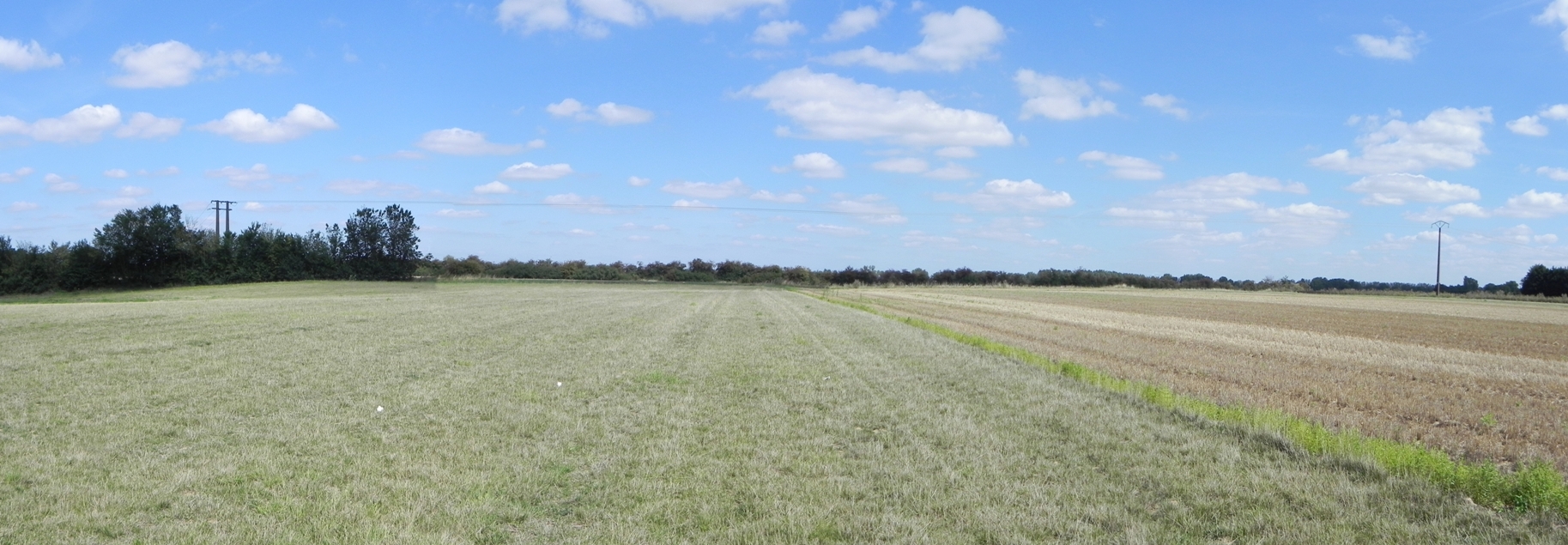
The field where Jack Davies performed the deeds which led to his VC award. German troops had crossed the canal and were coming directly towards this spot.
According to the after-action report compiled in the war diary it was in these two innocuous fields that Jack Davies mounted the parapet and kept his Lewis Gun firing until overwhelmed by the advancing Germans.
For most conspicuous bravery and devotion to duty under heavy rifle and machinegun fire. When his company – outflanked on both sides – received orders to withdraw, Corporal Davies knew that the only line of withdrawal lay through a deep stream lined with a belt of barbed wire, and that it was imperative to hold up the enemy as long as possible.
He mounted the parapet, fully exposing himself, in order to get a more effective field of fire, and kept his Lewis gun in action to the last, causing the enemy many casualties and checking their advance. By his very great devotion to duty he enabled part of his company to get across the river, which they would otherwise have been unable to do, thus undoubtedly saving the lives of many of his comrades. When last seen this gallant N.C.O. was still firing his gun, with the enemy close on the top of him, and was in all probability killed at his gun.
Quite how and why he wasn’t killed remains unknown but it was only two months later, after his VC citation had been published in the London Gazette that word reached home that he was a POW in Germany. It was safely assumed that Jack was killed in the action and so the citation (above) is written as a posthumous record of his bravery.
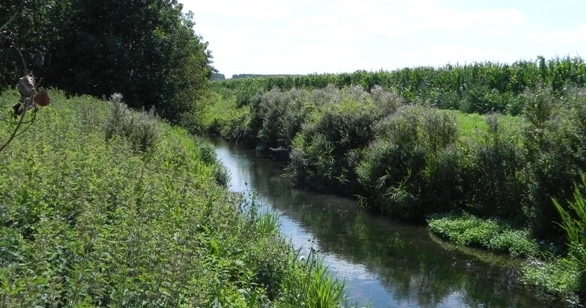
The "deep stream lined with a belt of barbed wire" over which the survivors of the 11th South Lancs escaped - now called the River d'Allemagne.
Roland laid a small cross in the field and we then paid our respects at Ham British Cemetery where other men of the 11th South Lancs who hadn’t the same luck as Jack are buried. It was a spot I hadn’t visited before and I was taken by the two cemeteries – the British and Commonwealth cemetery directly next to the Muille-Villette German Cemetery.

Ham British Cemetery. The black crosses of the neighbouring German cemetery can just be made out above the Portland stone headstones.

A view from the German cemetery - the gravestones of German and British soldiers lie almost side-by-side.
Before leaving I laid a cross at the grave of Lieutenant John Cuthbert Lidgett, 11th South Lancs in memory of all the men of the battalion who made the ultimate sacrifice. It had been a real trip to remember….
“What a wonderful day you provided for me, far exceeding my expectations for our time together. I mentioned the words ‘bringing alive’ and certainly you did that both for the 1 July 1916 action on the Somme and also Jack’s story from 21-24 March 1918. I have no idea how many similar stories you have so far put together, but I cannot think that anyone trying to trace the steps of a long lost relative would regret having made contact with you. If this is the source of your livelihood, then I can see nothing but success ahead.” Roland Parr, Cambridge
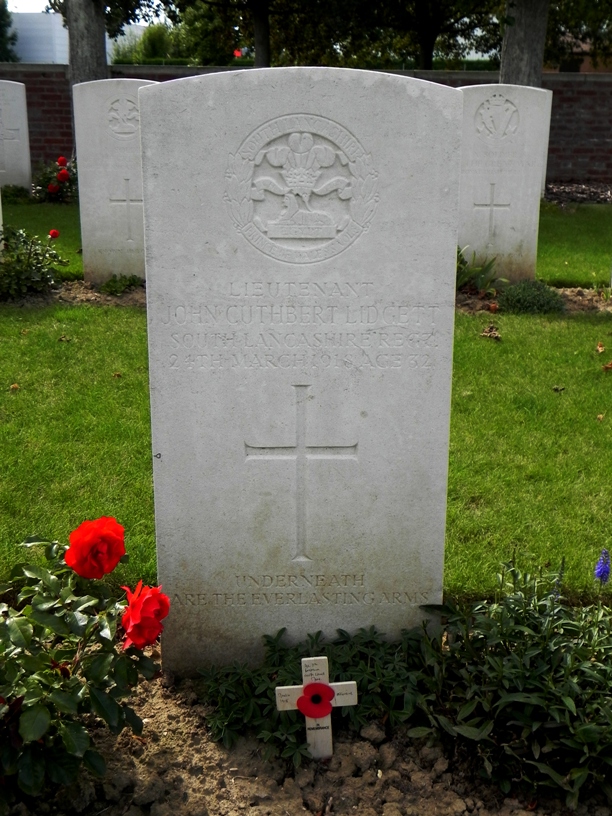
The grave of Lieutenant John Cuthbert Lidgett, 11th South Lancs in Ham British Cemetery. The cross was placed in memory of all the men of the battalion who made the ultimate sacrifice.
What a wonderful day you provided for me, far exceeding my expectations for our time together. I mentioned the words ‘bringing alive’ and certainly you did that both for the 1 July 1916 action on the Somme and also Jack’s story from 21-24 March 1918. I have no idea how many similar stories you have so far put together, but I cannot think that anyone trying to trace the steps of a long lost relative would regret having made contact with you. If this is the source of your livelihood, then I can see nothing but success ahead.
Roland Parr,
Last week I spent an enjoyable two days on the battlefields with four clients. For all but one of them it was their first visit to the western front. We met bright and early on Monday morning at the Channel Tunnel terminal and travelled over in convoy down to Arras.
Arras
Our first stop was in the superb Carriere Wellington. Our guide, the irrepressible Pascal, was as keen as ever and coupled with my preliminary talk on the Battle of Arras and the ten minute ‘taster’ film shown prior to going underground my group got a good initial grasp of the battle in April & May 1917. Following our hour underground we visited the Arras Memorial to the Missing and Faubourg d’Amiens Cemetery. The sheer scale of men with no known grave from the Arras battlefields had the usual sobering effect.
Being so close we popped into the Mur des Fusillés and paid our respects at the site where 218 French resistance and civilians were shot by the Germans in the Second World War. I have always found it an eerie place with a strange atmosphere all of its own.
We then headed out to the Great War battlefields around Arras with the first stop the Point du Jour for a visit to the military cemetery and the graves of the 10th Lincolns men (Grimsby Chums) found in 2001 and the impressive 9th (Scottish) Division memorial re-sited next to the cemetery. After a picnic lunch in the cemetery we headed back into Athies and along to Fampoux. The village marked the point of furthest advance into German lines on 9 April 1917. We stopped at the sunken lane to look at the attack of the 2nd Seaforth Highlanders and 1st Royal Irish Fusiliers (10th Brigade, 4th Division) against Greenland Hill and Roeux on 11 April 1917. Whilst at the Sunken Lane Cemetery overlooking the sloping fields down to Roeux I told my group of Donald MacKintosh and the actions that earned his Victoria Cross. We then drive through Roeux past the site of the Chemical Works (now a Carrefour mini-supermarket) and around to Brown’s Copse Cemetery to pay our respects at MacKintosh’s grave.
Back on the road we crossed the Scarpe and headed up to Monchy-le-Preux. I pointed out the positions of various trench lines and explained about the catastrophic failure of the 3 May attack, the Third Battle of the Scarpe. We then had a drive around Monchy, stopping at the stunning 37th Division memorial and the Newfoundland Caribou Memorial which is built on the top of a British artillery observation post constructed in August 1917 by 69 Field Company RE. Our day’s battlefielding was completed with a stop east of the village on Infantry Hill where I told of the disastrous 14 April attack by 1st Essex Regiment and the aforementioned Newfoundlanders. Both battalions were destroyed in carefully planned German counter-attacks – the first use of the new doctrine of ‘elastic’ defence. Monchy was at the mercy of the Germans and the situation was only saved by the quick thinking action of Lt-Colonel James Forbes-Robertson and a small group of men – all decorated for this action and known thereafter as the Heroes of Monchy.
We had a pleasant walk up Infantry Hill to the Mound and then headed back into Arras to pick up my car and then headed down to the Somme for a welcome meal and good night’s sleep.

The view of Infantry Hill from Green Lane. Bois du Vert sits on the horizon to the right of the picture.
The Somme
The next day was spent touring the 1916 Somme battlefield. Very much aware that one can only skim over the surface with one day around such a large and important battlefield we were up early to make full use of the daylight. After an explanation in the car park on the battle using various maps we set off north up to Serre, the most northerly point of continuous attack on 1 July 1916. En route we pulled the car in at the Ulster Tower for a view across the Ancre and an explanation of events in the northern part of the battlefield. The Gospel Copses at Serre were deserted and we had Sheffield Memorial Park all to ourselves as I explained about the failure of the attack and the losses incurred by the northern Pals battalions of the 31st Division.
After some time in Railway Hollow Cemetery we stopped at Serre Road Cemetery No.2 (the largest on the Somme battlefield) and the across the Redan Ridge to Beaumont Hamel, and the infamous sunken lane, the jumping off point for the 1st Lancashire Fusiliers that fateful morning. We then retraced our steps and stopped for a pleasantly quiet walk around the preserved trenches of Newfoundland Memorial Park with its Caribou and even more imposing memorial to the 51st (Highland) Division, conquerors of Beaumont Hamel in November 1916. Our next stop was to the magnificent Thiepval Memorial to the Missing, a must for any battlefield visitor to the western front. Heading via Pozières of Australian fame we reached the Old Blighty Tea Rooms at La Boisselle for a deserved late lunch.
The afternoon began with a detailed tour around the Glory Hole at La Boisselle and a good walk around the site looking at the craters and depressions marking the trenches followed by a stop at the unmissable Lochnagar Crater.
We then headed east through the battlefield, past Contalmaison, Longueval and Guillemont to the Cedric Dickens cross at Ginchy overlooking Leuze and Bouleaux Woods. This was a special stop for one of the group whose grandfather had served with the 1/8th Middlesex Regiment and who had probably been in these very fields in mid-September 1916.

Jack & John with Bouleaux Wood in the background. John’s grandfather served here in September 1916 with the 1/8th Middlesex Regiment.
Our final stop of the day was to the site above Mametz of our successful archaeological dig for a Livens Large Gallery Flame Projector where I could stand my clients on the spot where the parts had been recovered in May 2010. Sadly we did not have time to all visit the Historial de la Grande Guerre at Peronne to see the temporary exhibition and salvaged projector parts as well as the full size replica but there is only so much we could do within the time constraints.
“I would just like to say a big thank you for making our battlefield tour such an interesting and amazing event. Your knowledge of the area and what went on and where, is just incredible. The tour was made that much better by the fact that you had researched my Grandfather’s service in the Middlesex Regiment and proceeded to show us exactly where he was and what he would have experienced almost to the day but 95 years ago. It made the hair stand up on the back of my neck!
The choice of locations that you picked were excellent, and whilst I know two days is not long enough to cover everything there is to see, we certainly got a very good understanding of what happened, by whom and where. This was made even more poignant by linking them to my ancestors who had fought there. I would have no hesitation in recommending your tours to any of my friends, in fact I have told them of my experience with you and we are already planning another tour for next year.” John Waterman, Kent
It was a terrific trip with delightful people who have clearly got the battlefielding bug. My thanks to John, Clare, Sally and Jack for their enthusiasm, understanding and for sending me a selection of photos. I am already looking forward to the next time…
Today sees the public launch of our ambitious project at the Glory Hole in the village of La Boisselle at the heart of the Somme battlefields. We have been invited by the landowners to conduct a long-term archaeological and historical study into the site, one of the most unique still extant on the western front.
BBC Breakfast and News 24 are covering the launch with Robert Hall on live feed from the Somme. He will be interviewing members of the La Boisselle Study Group (Peter Barton, Simon Jones and Iain McHenry) as well as one of the landowners who has given us this tremendous opportunity. Owing to other commitments I am not able to be on site today with my colleagues but am enjoying seeing the reaction in the UK.
For all details of the project please see our website: http://www.laboisselleproject.com/
The detailed article on the BBC website can be read here: http://www.bbc.co.uk/news/magazine-13630203


